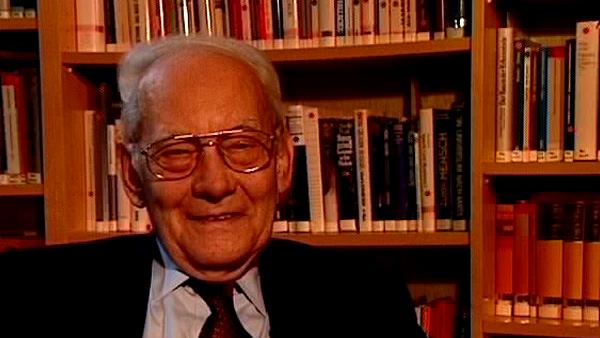NEXT STORY

Reasons to focus into a small volume element
RELATED STORIES

NEXT STORY

Reasons to focus into a small volume element
RELATED STORIES


|
Views | Duration | |
|---|---|---|---|
| 81. Rudolf Rigler: looking at fluctuations | 182 | 02:32 | |
| 82. Rigler's method of determining the rotation of single molecules | 84 | 02:46 | |
| 83. Reasons to focus into a small volume element | 89 | 01:46 | |
| 84. Using fluorescence correlation spectroscopy to observe a single... | 453 | 03:25 | |
| 85. Using primers to see single particles | 70 | 04:26 | |
| 86. Using nanotechnology to do evolutionary experiments | 57 | 04:20 | |
| 87. Viruses | 64 | 03:39 | |
| 88. Using viruses as models for evolution | 42 | 02:57 | |
| 89. The evolution of HIV | 49 | 03:28 | |
| 90. Anti-viral strategies | 39 | 04:49 |


Now what is the trick of this method? I must perhaps try to explain that. First of all, you must choose a very small volume element. You have to... and, therefore, you need a laser. Only a laser with a coherent light you can focus into a small enough volume element.
[Q] What means 'small enough'?
Yes. Small. That's a good question. In our present work the volume element is almost a tenth of a femtolitre. Femtolitre is 10-15 litre, or what is better, a femtolitre is the size of a coli cell. That means about one micron in each direction. Three dimensions. One micron. And so we go to fractions of a micron. That volume is only a thousandth of an ordinary normal eukaryotic somatic cell also. So you can see it's smaller than the cells of living organisms, much smaller, and you could... even if you can do observations of such small volume elements, you can look inside a cell. So, that's what we do. In order to get there you need two technical improvements. One was the laser. Now present lasers are stable enough... we can focus them into that volume element and we can use the laser light for fluorescence measurements, I come to that. And second, you need good optics to focus it and that is called confocal optics. And confocal optics was invented by Marvin Minsky... by the neuro... who works nowadays on theoretical neural networks and things he became known for.
[Q] Artificial intelligence, and things like that...
Things like that. But he invented the confocal optics in this work, and this is available now and companies like Zeiss build very good instruments with very corrected lenses and so... so that is no problem nowadays to focus light into such small volume element.
Nobel Prize winning German biophysical chemist, Manfred Eigen (1927-2019), was best known for his work on fast chemical reactions and his development of ways to accurately measure these reactions down to the nearest billionth of a second. He published over 100 papers with topics ranging from hydrogen bridges of nucleic acids to the storage of information in the central nervous system.
Title: Rigler's method of determining the rotation of single molecules
Listeners: Ruthild Winkler-Oswatitch
Ruthild Winkler-Oswatitsch is the eldest daughter of the Austrian physicist Klaus Osatitsch, an internationally renowned expert in gas dynamics, and his wife Hedwig Oswatitsch-Klabinus. She was born in the German university town of Göttingen where her father worked at the Kaiser Wilhelm Institute of Aerodynamics under Ludwig Prandtl. After World War II she was educated in Stockholm, Sweden, where her father was then a research scientist and lecturer at the Royal Institute of Technology.
In 1961 Ruthild Winkler-Oswatitsch enrolled in Chemistry at the Technical University of Vienna where she received her PhD in 1969 with a dissertation on "Fast complex reactions of alkali ions with biological membrane carriers". The experimental work for her thesis was carried out at the Max Planck Institute for Physical Chemistry in Göttingen under Manfred Eigen.
From 1971 to the present Ruthild Winkler-Oswatitsch has been working as a research scientist at the Max Planck Institute in Göttingen in the Department of Chemical Kinetics which is headed by Manfred Eigen. Her interest was first focused on an application of relaxation techniques to the study of fast biological reactions. Thereafter, she engaged in theoretical studies on molecular evolution and developed game models for representing the underlying chemical proceses. Together with Manfred Eigen she wrote the widely noted book, "Laws of the Game" (Alfred A. Knopf Inc. 1981 and Princeton University Press, 1993). Her more recent studies were concerned with comparative sequence analysis of nucleic acids in order to find out the age of the genetic code and the time course of the early evolution of life. For the last decade she has been successfully establishing industrial applications in the field of evolutionary biotechnology.
Tags: small volume element, lasers, confocal optics, Carl Zeiss AG, ZEISS, artificial intelligence, Rudolf Rigler, Marvin Lee Minsky
Duration: 2 minutes, 47 seconds
Date story recorded: July 1997
Date story went live: 29 September 2010